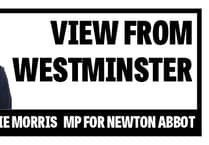WHEN the film Underground opened at Newton Abbot’s long-departed Imperial Cinema 94 years ago in October 1929 its three-panelled local newspaper advertisement trumpeted: ‘First time in the West of England… featuring Newton’s famous cinema star Norah Baring', writes author Brian Thomas.
For just sixpence – or, if you were a little more flush and aiming for a better seat, one-and-sixpence – you could settle down to 84 minutes in the fictional company of ‘ordinary Londoners and the romance between them,’ their lives set on and around the London underground.
And, as a patron, you might also have known or recognised its local star, who studied art in Newton Abbot and who played seamstress Kate opposite fellow thespians Brian Aherne, Cyril McLaglen and Italian-born actress Elissa Landi, to whom Norah was often compared.

The film has been described as ‘part thriller, part time capsule… and an intriguing portrait of 1920s London… The underground in Underground is more than a metaphor for the repressed passions of four ordinary workaday people, it is integral to the plot, and its shadowy locations set the film’s tone…’
It follows four characters whose lines intersect, as one woman’s accidental encounter with two strangers leads to both romance and violence. Bert and Bill are both in love with Nell, which sets them against each other, and Kate (Norah) is in love with Bert, which leads her to confront him and Nell. Bert (McLaglen) is an engineer at the tube’s power station, Bill (Aherne) is a porter, Kate sews, while pretty Nell (Landi) sells fancy scarves in a department store.
There is a mix of humour, emotional drama and action sequences including an acrobatic pursuit from the roof, across a building site and down into the tunnels of the tube, before a sweaty finale in a crowded lift. All topped off with what was described as “an unnerving performance from spindly Norah Baring.”
Following her netting the role, the lively 24-year-old told reporters: ‘After I had been at school at Plymouth for six years and had studied at the Newton Abbot Art School, I came to London with the sole idea of being an artist.’
But this was not to be – in the painting of canvasses at any rate. For she told Film Weekly: ‘Having realised early, clearly and painfully, that a childish talent for drawing and painting, though encouraged by kind friends and relations, did not constitute a vocation, I tried the stage.’

She studied under a well-know actress of the day Rosina Phillippi and her first significant appearance on the boards came in James Barrie’s play A Kiss For Cinderella, in a part specially written for her. But her ‘type’, with her dark, non-peroxide hair and lack of doe eyes, did not lend itself to UK film requirements at that time, so she sought a career in Germany. Here she was ironically ‘discovered’ by two Englishmen and, after some ‘bit’ parts in Swedish and German productions, she was eventually introduced to the young Anthony Asquith who directed her in both Underground and A Cottage on Dartmoor.
Londoner Asquith (1902-1968) – son of a Liberal Prime Minister – went on to enjoy a 40-year career that would see him working with stars such as Leslie Howard, Laurence Olivier, Michael Redgrave, John Mills, Dirk Bogarde, Rex Harrison and Richard Burton and meeting various early Hollywood glitterati including Mary Pickford, Douglas Fairbanks, Charlie Chaplin and Lillian Gish.
Underground was made by British Instructional Films at Elstree and Cricklewood Studios and on location at Lots Road power station in Chelsea and Waterloo railway station, and for Norah it proved to be a springboard. She went on to appear in a host of films, including 1930’s critically-acclaimed Murder! under director Alfred Hitchcock where she played a young girl convicted of murder but thought innocent by juror Herbert Marshall.
As the director said at the time: ‘We did many things that had not been done before. It was Herbert Marshall’s first talking part and the role was perfect for him; he turned out to be excellent in the sound medium. Anyway, we had to reveal his inner thoughts and since I hate to introduce a useless character in the story I used a stream of consciousness monologue. At the time this was regarded as an extraordinary novelty, although it has been done for ages in the theatre, beginning with Shakespeare.’
Norah’s favourite film of that era was A Cottage on Dartmoor where she played a young farmer’s wife threatened by a former lover on the run from Dartmoor Prison. She told a weekly film magazine: ‘My part in that was strongly emotional with some lighter touches, which is exactly what I want to play.’
In the 1931 thriller Should a Doctor Tell? – with a script by mystery writer Edgar Wallace – Norah played the fiancée of the son of a doctor haunted by memories of his refusal to violate a patient’s confidence in a court case. It was described in a Mid-Devon Advertiser film column that year – the year Norah gave birth to a daughter – as ‘a picture of real, gripping power’.
But it was all to be a short-lived experience and by 1932 the offers declined and the popular actress eventually disappeared from public life, unsettled by her opposing obsessions of fame and obscurity.
She had already set out her conflicted state two years earlier when she mused: ‘I long to be famous. I should like to be an actress that people turn to look at in the street. But to do that you have to sacrifice so much that really matters. You have to pose and give parties and go out a lot, and to make love to people you don’t like; and you have to live up to the usual reputation of an actress.
‘I can’t do that! I won’t do that. I suppose it’s my greatest fault – the fact that I can’t make up my mind. Sometimes I think I’m a fool and try to change. I want to be famous so much, really famous I mean, but in the end I dither about and go back to my old ways. But why should I change? I want to be a successful wife more than I want to be a successful actress.’
Before she vanished into apparent obscurity, she even rejected an offer from Douglas Fairbanks to help her gain a contract in Hollywood as she did not want to sacrifice the things she truly loved for the sake of her work. It is recorded that some of her happiest times were spent cleaning stables in Sussex or riding on the Downs near Lewes.
Auguring that future, she apparently told screen writer Nerina Shute: ‘Most of my friends are country people, and when I’m with them I never behave as an actress should. I want to be the same as they are. I want to retire from the screen and have children and go in for gardening and picnics and heaven knows what.
‘Then I come back to town and mix with my husband’s friends – artists and writers and sculptors and brainy people who make me feel scared – and I find that I want to be serious, just as they are, and do things that matter, and forget about work-a-day things like children.’
Born Norah Minnie Baker in Acton in 1905, she married solicitor Ronald Montague Simon in 1928 who she met in a village near Nice the previous year. They honeymooned at the Italian Lakes and in the South of France and moved to a mews flat in Kensington ‘packed with books, old chairs and tables, soft colours and flower arrangements’. She married twice more before she died in 1985 in Puttenham, Surrey, succumbing to bronchial pneumonia.
Her cinema blood continues today through her great-grandnephew, assistant director/director Andrew Mckenzie, who has worked on a host of popular movies including Rogue One: A Star Wars Story (2016) as assistant to director Gareth Edwards, In the Heart of the Sea (2015) as 2nd unit assistant director, additional photography, Mission: Impossible: Rogue Nation (2015) as 2nd unit assistant director, and Jurassic World: Fallen Kingdom (2018) as assistant director.
As for Asquith’s minor classic Underground: at the time of its release it was unanimously praised by critics for its realism, with one writer adding that every British exhibitor should be proud to show it ‘because nothing more original or provocative has ever been produced. The British film industry owes a debt of gratitude to this distinguished film.’ Surely something for the 5ft 4in performer – ‘Newton’s famous cinema star’ who once lived at Pembroke Lodge ( now 4 Station Road), Newton Abbot, in her 1920s art school days – to be have been rightly proud.
The 80-year-old film was restored in 2009 under the auspices of the British Film Institute (BFI) and in 2011 composer and silent film accompanist Neil Brand wrote a completely new score which was then premiered by the BBC Symphony Orchestra at the Barbican Centre in London.
A contemporary review of that restoration, on the IMDb film website, describes Underground as a ‘cinematic feast’, the viewer adding: ‘The direction by Anthony Asquith is the thing that has really stood the test of time.
‘The plot flows in a simple but effective way, and the actors do a great job in bringing life and soul to a lively London town…The fact that the film closed to a round of applause from the audience says a great deal to me. A little peep of a bygone age, when men gave their seat up for women on public transport...’
The 500-seater Imperial Cinema where Underground was originally shown was located in Queen Street at its junction with Lemon Road. It opened in September 1913 and closed in January 1962 and during its half-century showed films – the silents accompanied as in most cinemas of the time firstly by piano, then small orchestra, then organ – and staged an occasional light entertainment show.
According to historian Philip Carter, the Imperial presented a string of war-oriented films during World War One, including a 1918 screening of the then-topical film No Man’s Land to Blighty in aid of the Red Cross, and staged a special Warriors’ Day show in 1921 with proceeds going to the Earl Haig Fund.
The theatre was partly demolished in 1983 after being empty for more than a decade and a car showroom replaced its former foyer. The ground floor is now occupied by an estate agent’s and a carpet outlet.
► Norah’s main filmography is: Underground (1928), Parisiennes (1928), The Celestial City (1929), The Runaway Princess (1929), A Cottage on Dartmoor (1929), Murder! (1930), Should a Doctor Tell? (1930), Two Worlds (1930), At the Villa Rose (1930), The Lyons Mail (1931), Strange Evidence (1933), The House of Trent (1933) and Little Stranger (1934).




